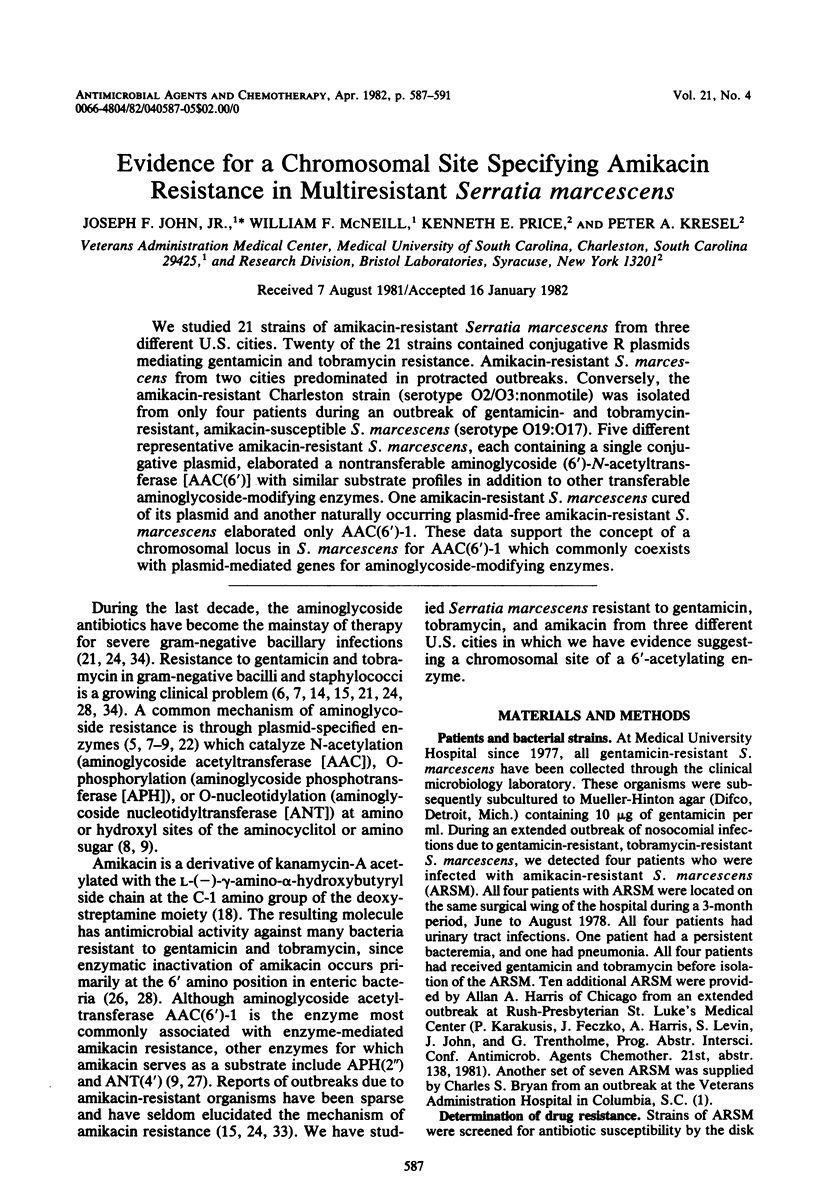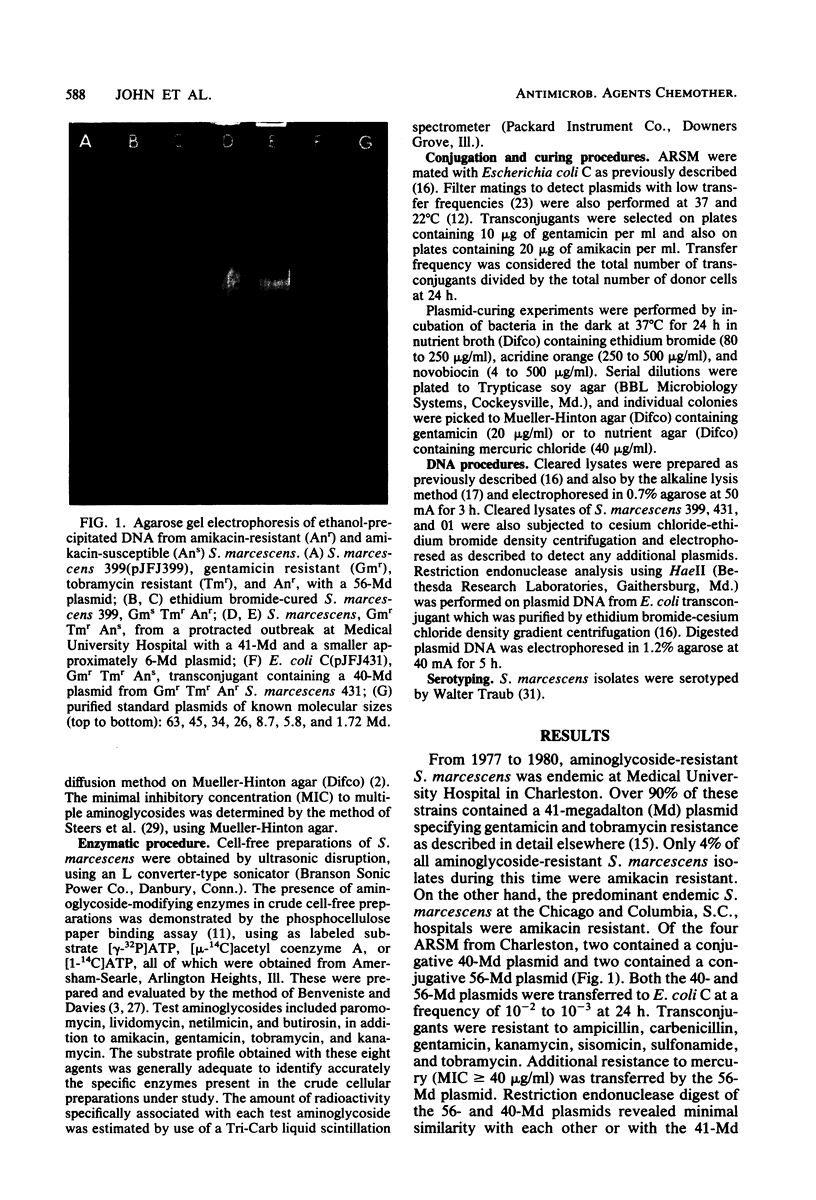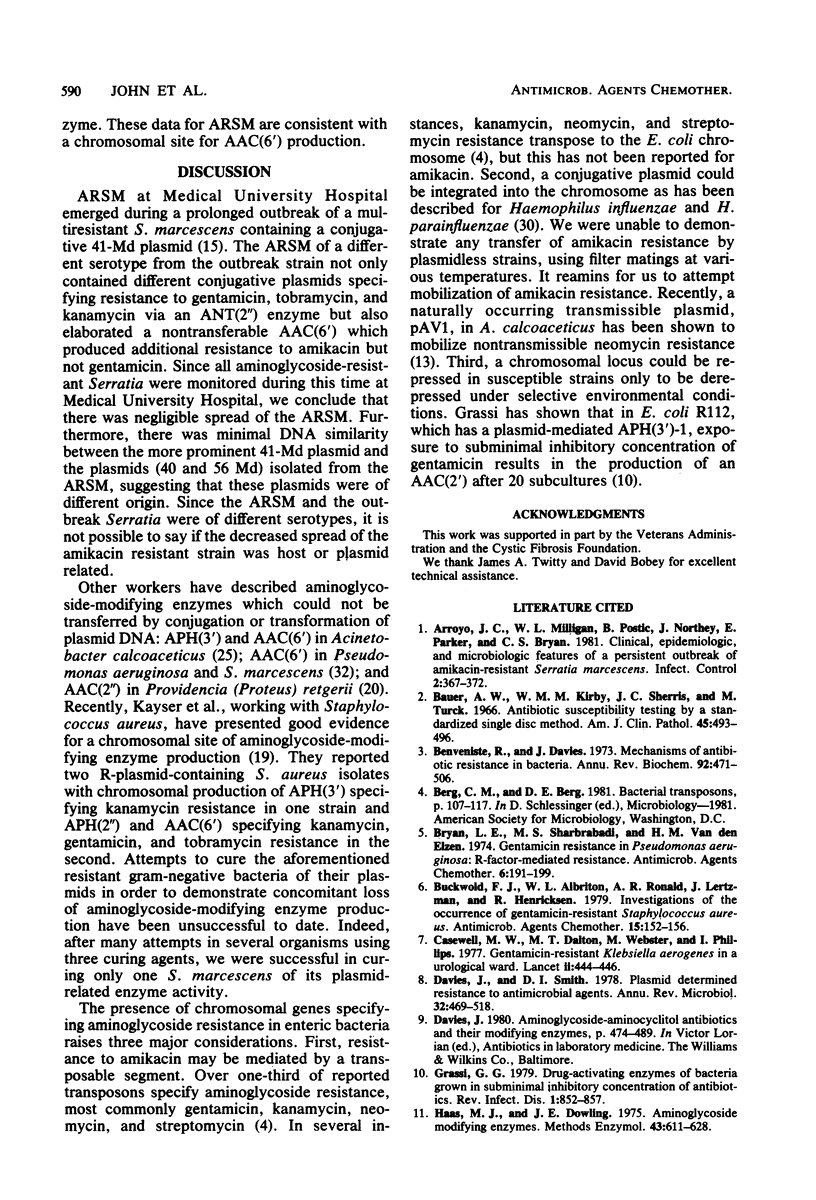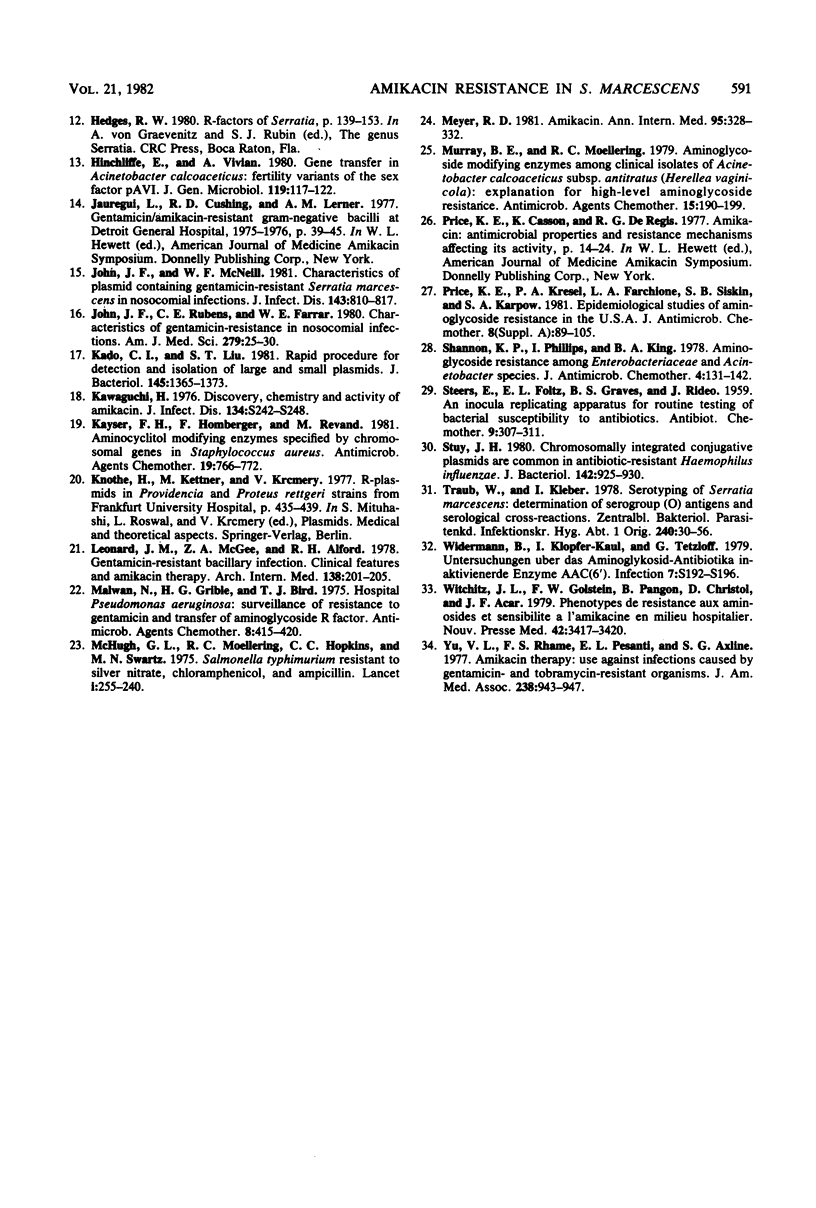Abstract
We studied 21 strains of amikacin-resistant Serratia marcescens from three different U.S. cities, Twenty of the 21 strains contained conjugative R plasmids mediating gentamicin and tobramycin resistance. Amikacin-resistant S. marcescens from two cities predominated in protracted outbreaks. Conversely, the amikacin-resistant Charleston strain (serotype 02/03:nonmotile) was isolated from only four patients during an outbreak of gentamicin- and tobramycin resistant, amikacin-susceptible S. marcescens (serotype O19:O17). Five different representative amikacin-resistant S. marcescens, each containing a single conjugative plasmid, elaborated a nontransferable aminoglycoside (6')-N-acetyltransferase [AAC(6')] with similar substrate profiles in addition to other transferable aminoglycoside-modifying enzymes. One amikacin-resistant S. marcescens cured of its plasmid and another naturally occurring plasmid-free amikacin-resistant S. marcescens elaborated only AAC(6')-1. These data support the concept of a chromosomal locus in S. marcescens for AAC(6')-1 which commonly coexists with plasmid-mediated genes for aminoglycoside-modifying enzymes.
Full text
PDF




Images in this article
Selected References
These references are in PubMed. This may not be the complete list of references from this article.
- Arroyo J. C., Milligan W. L., Postic B., Northey J., Parker E., Bryan C. S. Clinical, epidemiologic and microbiologic features of a persistent outbreak of amikacin-resistant Serratia marcescens. Infect Control. 1981 Sep-Oct;2(5):367–372. doi: 10.1017/s0195941700055508. [DOI] [PubMed] [Google Scholar]
- Bauer A. W., Kirby W. M., Sherris J. C., Turck M. Antibiotic susceptibility testing by a standardized single disk method. Am J Clin Pathol. 1966 Apr;45(4):493–496. [PubMed] [Google Scholar]
- Benveniste R., Davies J. Mechanisms of antibiotic resistance in bacteria. Annu Rev Biochem. 1973;42:471–506. doi: 10.1146/annurev.bi.42.070173.002351. [DOI] [PubMed] [Google Scholar]
- Bryan L. E., Shahrabadi M. S., van den Elzen H. M. Gentamicin resistance in Pseudomonas aeruginosa: R-factor-mediated resistance. Antimicrob Agents Chemother. 1974 Aug;6(2):191–199. doi: 10.1128/aac.6.2.191. [DOI] [PMC free article] [PubMed] [Google Scholar]
- Buckwold F. J., Albritton W. L., Ronald A. R., Lertzman J., Henriksen R. Investigations of the occurrence of gentamicin-resistant Staphylococcus aureus. Antimicrob Agents Chemother. 1979 Feb;15(2):152–156. doi: 10.1128/aac.15.2.152. [DOI] [PMC free article] [PubMed] [Google Scholar]
- Casewell M. W., Dalton M. T., Webster M., Phillips I. Gentamicin-resistant Klebsiella aerogenes in a urological ward. Lancet. 1977 Aug 27;2(8035):444–446. doi: 10.1016/s0140-6736(77)90621-3. [DOI] [PubMed] [Google Scholar]
- Davies J., Smith D. I. Plasmid-determined resistance to antimicrobial agents. Annu Rev Microbiol. 1978;32:469–518. doi: 10.1146/annurev.mi.32.100178.002345. [DOI] [PubMed] [Google Scholar]
- Grassi G. G. Drug-inactivating enzymes of bacteria grown in subminimal inhibitory concentrations of antibiotics. Rev Infect Dis. 1979 Sep-Oct;1(5):852–857. doi: 10.1093/clinids/1.5.852. [DOI] [PubMed] [Google Scholar]
- Haas M. J., Dowding J. E. Aminoglycoside-modifying enzymes. Methods Enzymol. 1975;43:611–628. doi: 10.1016/0076-6879(75)43124-x. [DOI] [PubMed] [Google Scholar]
- Hinchliffe E., Vivian A. Gene transfer in Acinetobacter calcoaceticus: fertility variants of the sex factor pAV1. J Gen Microbiol. 1980 Jul;119(1):117–122. doi: 10.1099/00221287-119-1-117. [DOI] [PubMed] [Google Scholar]
- John J. F., Jr, McNeill W. F. Characteristics of Serratia marcescens containing a plasmid coding for gentamicin resistance in nosocomial infections. J Infect Dis. 1981 Jun;143(6):810–817. doi: 10.1093/infdis/143.6.810. [DOI] [PubMed] [Google Scholar]
- John J. F., Jr, Rubens C. E., Farrar W. E., Jr Characteristics of gentamicin resistance in nosocomial infections. Am J Med Sci. 1980 Jan-Feb;279(1):25–30. doi: 10.1097/00000441-198001000-00003. [DOI] [PubMed] [Google Scholar]
- Kado C. I., Liu S. T. Rapid procedure for detection and isolation of large and small plasmids. J Bacteriol. 1981 Mar;145(3):1365–1373. doi: 10.1128/jb.145.3.1365-1373.1981. [DOI] [PMC free article] [PubMed] [Google Scholar]
- Kawaguchi H. Discovery, chemistry, and activity of amikacin. J Infect Dis. 1976 Nov;134(Suppl):S242–S248. doi: 10.1093/infdis/135.supplement_2.s242. [DOI] [PubMed] [Google Scholar]
- Kayser F. H., Homberger F., Devaud M. Aminocyclitol-modifying enzymes specified by chromosomal genes in Staphylococcus aureus. Antimicrob Agents Chemother. 1981 May;19(5):766–772. doi: 10.1128/aac.19.5.766. [DOI] [PMC free article] [PubMed] [Google Scholar]
- Leonard J. M., McGee Z. A., Alford R. H. Gentamicin-resistant bacillary infection. Clinical features and amikacin therapy. Arch Intern Med. 1978 Feb;138(2):201–205. [PubMed] [Google Scholar]
- Maliwan N., Grieble H. G., Bird T. J. Hospital Pseudomonas aeruginosa: surveillance of resistance to gentamicin and transfer of aminoglycoside R factor. Antimicrob Agents Chemother. 1975 Oct;8(4):415–420. doi: 10.1128/aac.8.4.415. [DOI] [PMC free article] [PubMed] [Google Scholar]
- McHugh G. L., Moellering R. C., Hopkins C. C., Swartz M. N. Salmonella typhimurium resistant to silver nitrate, chloramphenicol, and ampicillin. Lancet. 1975 Feb 1;1(7901):235–240. doi: 10.1016/s0140-6736(75)91138-1. [DOI] [PubMed] [Google Scholar]
- Meyer R. D. Amikacin. Ann Intern Med. 1981 Sep;95(3):328–332. doi: 10.7326/0003-4819-95-3-328. [DOI] [PubMed] [Google Scholar]
- Murray B. E., Moellering R. C., Jr Aminoglycoside-modifying enzymes among clinical isolates of Acinetobacter calcoaceticus subsp. anitratus (Herellea vaginicola): explanation for high-level aminoglycoside resistance. Antimicrob Agents Chemother. 1979 Feb;15(2):190–199. doi: 10.1128/aac.15.2.190. [DOI] [PMC free article] [PubMed] [Google Scholar]
- Price K. E., Kresel P. A., Farchione L. A., Siskin S. B., Karpow S. A. Epidemiological studies of aminoglycoside resistance in the U.S.A. J Antimicrob Chemother. 1981 Jul;8 (Suppl A):89–105. doi: 10.1093/jac/8.suppl_a.89. [DOI] [PubMed] [Google Scholar]
- Shannon K. P., Phillips I., King B. A. Aminoglycoside resistance among Enterobacteriaceae and Acinetobacter species. J Antimicrob Chemother. 1978 Mar;4(2):131–142. doi: 10.1093/jac/4.2.131. [DOI] [PubMed] [Google Scholar]
- Stuy J. H. Chromosomally integrated conjugative plasmids are common in antibiotic-resistant Haemophilus influenzae. J Bacteriol. 1980 Jun;142(3):925–930. doi: 10.1128/jb.142.3.925-930.1980. [DOI] [PMC free article] [PubMed] [Google Scholar]
- Traub W. H., Kleber I. Serotyping of Serratia marcescens: determination of serogroup (O) antigens and serological cross-reactions. Zentralbl Bakteriol Orig A. 1978 Jan;240(1):30–56. [PubMed] [Google Scholar]
- Wiedemann B., Klopfer-Kaul I., Tetzlaff G. Untersuchungen über das Aminoglykosid-Antibiotika inaktivierende Enzym AAC-(6') IV. Infection. 1979;7 (Suppl 2):S192–S196. doi: 10.1007/BF01641122. [DOI] [PubMed] [Google Scholar]
- Witchitz J. L., Golstein F. W., Pangon B., Christol D., Acar J. F. Phénotypes de résistance aux aminosides et sensibilité à l'amikacine en milieu hospitalier. Nouv Presse Med. 1979 Oct 31;8(42):3417–3420. [PubMed] [Google Scholar]
- Yu V. L., Rhame F. S., Pesanti E. L., Axline S. G. Amikacin therapy. Use against infections caused by gentamicin- and tobramycin-resistant organisms. JAMA. 1977 Aug 29;238(9):943–947. doi: 10.1001/jama.238.9.943. [DOI] [PubMed] [Google Scholar]



